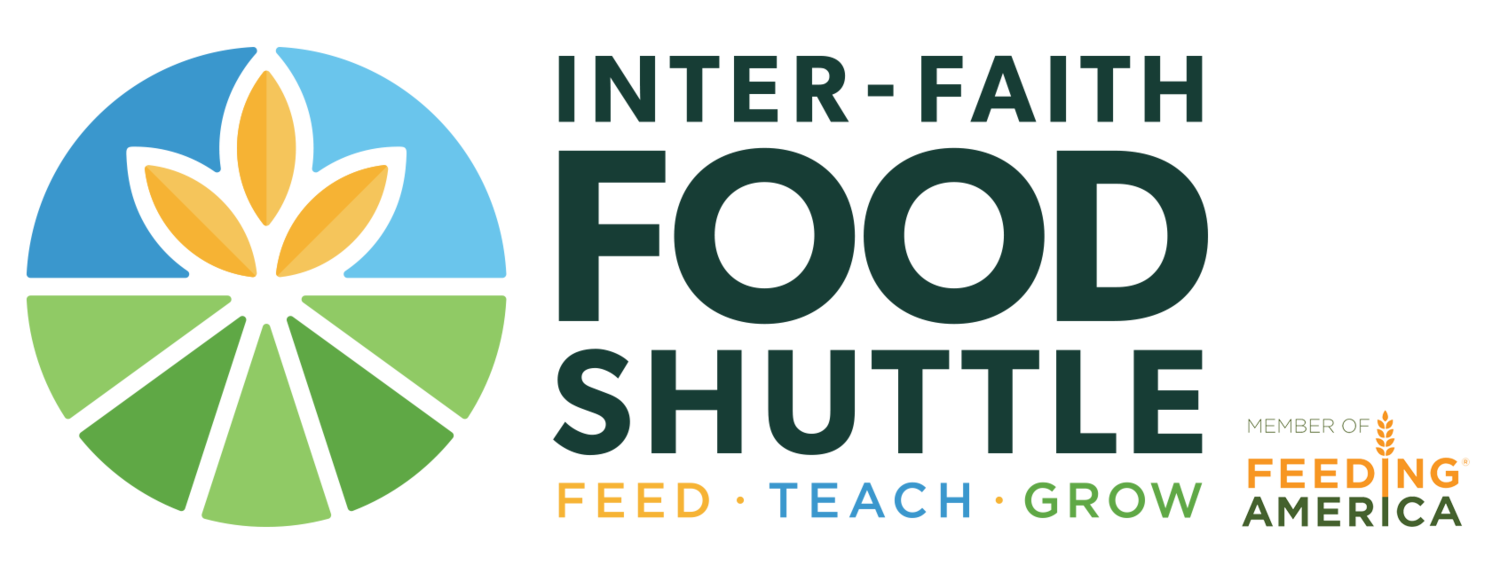More than one in four children in North Carolina have insufficient food to grow and be active, according to recent data. No Kid Hungry North Carolina is a partnership launched in September 2011 with the national nonprofit Share Our Strength and state leaders to connect children with nutritious food. It works with government, nonprofits and businesses to bring resources and solutions to the growing child hunger issue in North Carolina. Today the NC chapter of No Kid Hungry is holding their NC Child Hunger Leaders Conference in Chapel Hill. Leaders in the fight against childhood hunger will be convening, including a workshop with the Food Shuttle’s very own: Kyle Abrams! Visit www.nokidhungry.org to see the work being done in our communities and around the country.
In the Kitchen with the... Hubbies: Josh's Kitchen Sink Chili
I like recipes. I like recipes because I am not very good at making up my own. I'm creative... but only once I have a good base recipe to follow. My husband however, is great at taking all of the leftover and on-the-verge-of-getting-thrown-away produce from the week and producing an amazing meal. I wasn't around to see the entire process but as you can see, the end result was colorful and delicious. So, without further ado, I give you Josh's Kitchen Sink Chili (which he made with Vegan Cornbread).
Josh's Kitchen Sink Chili
Ingredients
- one large sweet potato, skin still on (but scrubbed clean)
- two onions, diced
- 28-oz can of diced tomatoes, with their juices
- one can of pinto beans, drained and rinsed
- one can of garbanzo beans, drained and rinsed
- one can of black beans, drained and rinsed
- 3 medium carrots, diced
- 4 celery stalks, diced
- 1 tablespoon cumin
- 2 teaspoons chili powder
- salt and pepper to taste
- one cup of cilantro, diced
Directions 1. Scrub sweet potato, carrots, and celery. Open tomatoes and beans; rinse cans of beans. 2. Dice potato, onions, carrots, and celery. 3. Dump tomatoes and their juices in a Dutch oven. Bring to simmer. Throw in all other ingredients. Let simmer for 25-30 minutes. 4. Sprinkle cilantro on top. Voila! You're done!
How much do Americans pay for fruits and vegetables?
by Sarah Paxson An article came out in the National Geographic about how much Americans pay for fruit and vegetables. The article included an interesting chart showing the differences in costs between produce commonly found in our grocery stores. It's worth taking a look!

I can't believe it's already been a year!
by Morgan Medders Sadly, this week marks the last of my yearlong term of service as an Americorps VISTA with the Inter-Faith Food Shuttle (IFFS). It has truly been a wonderful experience. The IFFS staff and volunteers never cease to amaze me. Even as they’ve grown to become my “IFFS family,” I am still impressed on a daily basis by their diligence, compassion, and constant enthusiasm. These people are some of the greatest I know.
The fact that it took me several weeks of working here full-time to get a grasp on what everyone does is a testament to the breadth of innovative strategies IFFS is using to combat hunger in North Carolina. Even though my world has mainly revolved around our nutrition programs, I can’t help but be proud of our other programs as well: from Backpack Buddies to field gleaning to the Culinary Job Training Program to urban agriculture and the Young Farmer Training Program to food stabilization and Catering with a Cause.
Something that stands out to me, as I look back over the course of the year, is change. And while at first these changes may seem like inconveniences, or perhaps even weaknesses, I’d argue quite the opposite. Ending hunger will not be accomplished while being stagnant. While the tons of food we redistribute each year are critical to local families who are struggling to put meals on the table, that alone is not going to solve the problem. The Food Shuttle gets this. We all will have to work together to create a just, sustainable, accessible, and healthful food system here in NC. Not only do the IFFS programs already attack a myriad of different causes and symptoms of hunger, new visions are continually being put into action. One such vision in action, the IFFS "Mobile Tastiness Machine" which is shown below.
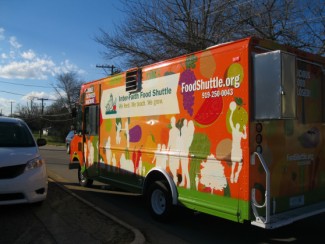
As people become more aware of where their food comes from, how to shop for and cook a healthy well-balanced meal no matter their budget, and find alternative ways to access nutritious foods, they feel empowered. I’ve seen it firsthand in our nutrition classes. I’ve felt it myself. It’s exciting to be able to grasp the power of nutritious food that comes from the earth to feed our families. This is nothing new, but unfortunately it’s been complicated by our current food system.
Over the past couple weeks, I have been asked several times what my favorite part of working with IFFS this year has been. As my typical indecisive self, I have had trouble coming up with an answer. Apart from the amazing people whom I mentioned above (and the shenanigans in the nutrition HUB), I think it would have to be the appreciation from community members. It’s not expressed at every encounter, but there have been countless times when someone has pulled me aside, in various classes, markets and events, to express gratitude for the work being done for the community. And there hasn’t been a CJTP graduation ceremony yet that I haven’t gotten teary eyed during the graduates’ stories, which always include some form of appreciation. The mission of IFFS is important, and the work is often fun, but it would be meaningless without the community supporting and appreciating it.
There is a long way to go yet, but boy am I excited to be a part of the journey.
As long as I’m in the area, I hope to continue to volunteer with the Inter-Faith Food Shuttle. Hopefully I will see you soon in a class or event or out in the field. Regardless, please be in touch: morgan.medders@gmail.com.
I've inserted pictures of some of my other favorite memories from my time here at the Food Shuttle.
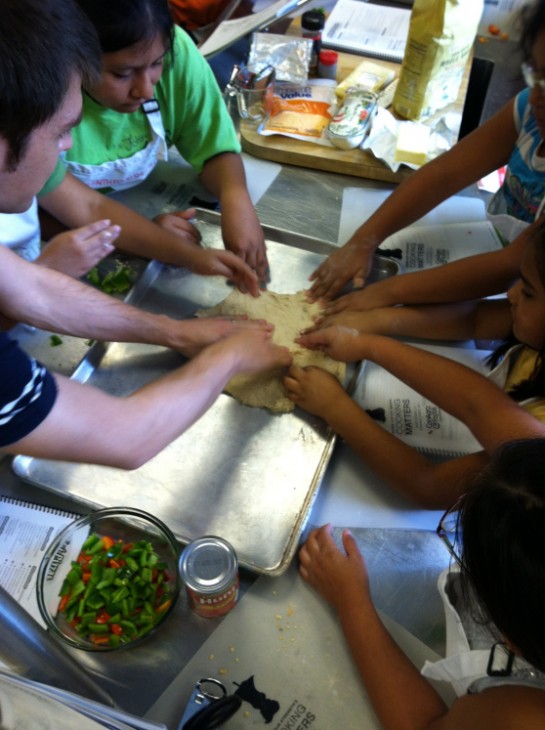
Making pizza during a Cooking Matters for Kids class. (One of the children wrote on his end of class survey, "P.S. I want to be a chef when I grow up.")

Office Shenanigans for my birthday.
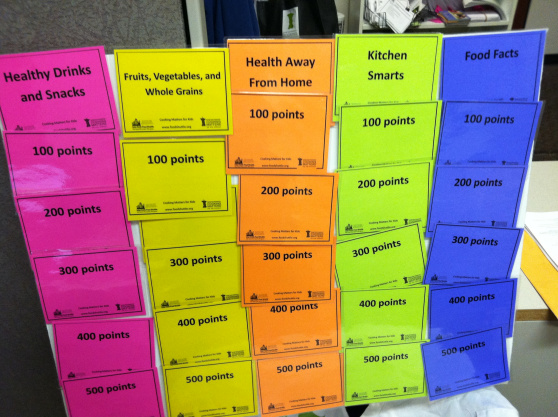
A VERY competitive game of Cooking Matters trivia.

BEAUTIFUL gifts of fresh produce and flowers from the Inter-Faith Food Shuttle Teaching Farm.
Kraft Easy Mac versus Stove Top Macaroni and Cheese
by Sarah Paxson This is a reoccurring series where we compare the nutrition facts of a pre-packaged, processed food item and it's "fresh food" counterpart.
The Food Matters Mobile Message for the month of February focuses on sodium, so this past week our Nutrition Outreach Coordinator set out to determine the difference in nutritional value between Kraft Easy Mac and a recipe we have for Stove Top Macaroni and Cheese.
We'll start with the Kraft Easy Mac. Their Easy Mac pouches contains 61g, with 230 calories per pouch. Its fiber content, one of the components of a diet that keeps you feeling fuller for longer (which cuts down overeating), is a measly 1g-- 4% of your daily value. Fat comes in at 4g, cholesterol comes in at <5mg (since it doesn't actually contain real milk or cheese, it doesn't contain cholesterol), carbs come in at 42g, and protein comes in at 5g. But here's the kicker: one pounch of Kraft Easy Mac contains 540mg of sodium-- 23% of your daily value!
Let's compare Stove Top Macaroni and Cheese. The serving size differed, so we calculated it so that it would match the 61g serving size of the Easy Mac pouches. In one serving of Stove Top Macaroni and Cheese, there are 121 calories. Fat comes in at 4g (same), cholesterol comes in at 10mg (more), carbs come in at 15.8 (way less), and protein comes in at 5.7g (slightly more). It also contains 2.4g of fiber, 2.5x more than Kraft Easy Mac. But sodium is the biggest difference: one serving of Stove Top Macaroni and Cheese contains just 154mg of sodium, nearly a fourth of the sodium!
Verdict: Stove Top Macaroni and Cheese has more of the good stuff like protein and fiber and less of the bad stuff like carbohydrates and sodium. Stove Top Macaroni and Cheese wins, plus you can't beat the taste.
In the Kitchen with the Hub: Ham, Bean and Kale Soup
by Jill Brown Any kale is great to have, but FREE kale from the IFFS farm is the best kind to have! After the alert went out that there was extra kale available for the taking, we sent our very own Katherine Moser over to get some for the folks who live in the HUB. This means that a part of my weekend was spent preserving the kale, as I had too much to eat all at once. One of my favorite ways to preserve greens is blanching and freezing into cubes for later sautéing or addition to soups or stews.
Follow these simple steps and you will be done in no time: 1. Clean the kale, removing any dirt or sand 2. Cut the leafy part of the kale off the stem 3. Add kale to a pot of hot water, swirl around for a couple of seconds and add to an ice bath to stop the enzymatic activity—this produces a nice, bright green/purple kale that will keep its color through freezing and thawing. Plus, it gets rid of some of the bitter flavors that can be found in raw green vegetables. 4. Allow the kale to dry a little 5. Add kale and a small amount of olive oil to a food processor and process until you make a smooth paste 6. Place the kale/oil mix into ice cube trays or if you have these nifty cocktail ice cube trays, they make really big cubes. 7. Freeze! Once frozen, remove the cubes from the trays and place in a freezer bag until needed.

Much like Pavlov’s dog, sautéing onions, shallots and garlic will get my teenager into the kitchen quickly! He immediately discovered my kale cube structure and had to check it out and determine if I had preserved cilantro [he was hoping] or kale. While it wasn’t what he was hoping for, he was happy to know I was making my ham and bean soup - with the addition of some kale, of course.
Ham, Bean and Kale Soup
First, dice: 1 yellow onion 1 small shallot 1 celery stalk 3 garlic cloves
And saute with: 2 tablespoons butter. (Yes, there is butter. I didn’t go all Paula Dean on us, but adding just enough butter provides enough fat to properly caramelize the onions.) Rinse, in order to remove sodium: 3 cans of beans [any kind] 1 lb. cubed ham
Combine everything together in a large pot along with: 8 cups of reduced sodium beef broth, or broth of your choice 2 teaspoons of parsley 1 teaspoon of allspice 1 teaspoons pepper 1 teaspoonsalt a large amount of kale-- as much as you'd like!
Bring to a boil and you are done – enjoy!
Feeding and Learning: Mobile Meals and a visit from Feeding America CEO Bob Aiken
Inter-Faith Food Shuttle's new food truck, which some of us call the Mobile Tastiness Machine, made a trial run on Thursday, feeding children bagged dinners at Neighbor To Neighbor’s after-school mentoring program - with Feeding America CEO Bob Aiken doing the honors. The newly installed CEO of the nation’s primary hunger relief organization was in Raleigh to meet with regional leaders from Feeding America, the nation's food bank network. But first, he wanted to see firsthand IFFS’s unique approach to ending hunger as a non-traditional food bank, including innovative programs in urban agriculture, farming, and job skills training. We showed him our new truck and then with our Board member, Smokey Norris of USFoods, he was off to feed children. The Mobile Tastiness Machine will be hitting the streets in selected neighborhoods later this spring, serving healthy meals prepared by our culinary staff to kids during out of school times, along with nutrition education, physical activity promotion, and bags of fresh produce for kids to take home to their families!
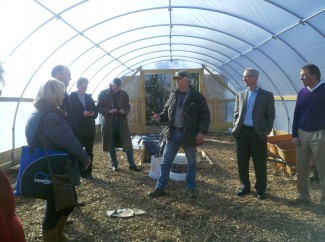

Get In The Greens!
by Sarah Paxson If you are like me, you have complained no less than two times a week, every week, for the last couple of months about the lack of fresh produce in the grocery stores. "That's it! We're doubling our tomato garden this spring! We're buying blueberry bushes! I mean, what are we supposed to eat?! We're going to starve!" I protested to my husband. (I may have a problem with exaggerating.)
Of course there are options for fresh and local produce, especially in the Piedmont where the weather is warm enough to grow food year-round. For instance, greens. My weekly CSA box is exploding with greens as of late. And the grocery stores? Fuggedaboutit!
But how can greens get added into our diets without becoming redundant The key is creativity. Everyone knows how to make a salad with a wide assortment of greens (and some delicious goat cheese). But what about incorporating greens into a more unusual places-- like breakfast?
Take eggs, for instance. You can saute spinach with diced onions in a skillet, mix some eggs in a bowl, add them to the skillet, and serve with a little cheese and a whole grain English muffin. Or, turn it into a breakfast burrito by adding some beans and salsa and wrapping it in a whole wheat tortilla.
Or what about making a Coconut Kale Smoothie, using coconut milk, cocoa powder, chia seeds, banana, cherries, and kale? Chock-full of vitamins A and K, not to mention antioxidants, this smoothie is the perfect mid-morning snack.
Jump outside the box and find new and delicious ways to incorporate greens into your every day diet!
Cheese 101
by Sarah Paxson What to buy―and how much―to create a delightful and delicious spread.
Select three to five cheeses, with approximately 1-2 ounces per person per cheese. Try to include a variety of textures and flavors, a cheese from each category. Most cheese belongs to one of four basic categories: aged, soft, firm, or blue.
Aged: Aged Cheddar, Goat Gouda Soft: Camembert Firm: Parmigiano-Reggiano, Manchego Blue: Gorgonzola, Valdeon
Cheese platters offer a great opportunity to try new things but don't be afraid to feauture at least one familiar cheese.
Cheese platters should always be served at room temperature to bring out the cheese's full flavor and texture, so take cheeses out of the fridge at least an hour before serving. Be sure to cut the cheese prior to a guest's arrival, to avoid awkward fumbling. Regular knives tend to cause goat and blue cheeses to crumble, so use a cheese wire. (If you don't have one, use dental floss!) When arranging the cheese on a cutting board, arrange them from mildest to strongest. This is done so that the strength of one cheese's flavor doesn't overpower the subtle flavors of another. And don't forget to write out labels so that you won't need to recite the names all evening!
Remember to provide a few simple accompaniments, such as fruits, nuts, chocolate, bread or crackers. Whatever is in season will have the best flavor, so use strawberries or blueberries in the summer and apples and pears in the fall and winter.
If you have leftovers, don't store the cheese in plastic wrap, which will make the cheese sweat and leave a plastic-y taste. Cheese needs to breathe, so wrap it in parchment or wax paper and keep in the fridge, usually the vegetable drawer.
Food Films for Change
It’s still January, the beginning of a new year, and we’re still thinking about change. While we may make our personal resolutions for self-improvement, issues like hunger require us all to work together toward change, resolved to create a hunger-free community where everyone has enough healthy, nutritious food to eat. For some food for thought, check out these recent and upcoming films exploring the interplay of nutrition, hunger, and the need for change in our food system across the state and across the nation:
Health Crisis in Carolina: Real Families. Real Struggles. Real Solutions.
This new documentary, produced by our partner Advocates for Health in Action (AHA), follows three North Carolina families as they learn ways to improve their eating habits and become more physically active. Its release coincides with the release of the NC Plan to Address Obesity in early February. The documentary is scheduled to air on Sunday, February 3rd at 1pm on UNC-TV. You can click this link to view the trailer: http://vimeo.com/55640574 and follow the film on their facebook page.
Soul Food Junkies
This film has already been released -- it first aired on January 14, 2013 on PBS Independent Lens -- but it’s an important one for exploring the issues of food justice. Check out the trailer here. If you missed it, PBS is streaming the documentary free until February 11th. You can watch it online here: http://video.pbs.org/video/2305721338
Description of this film from PBS Independent Lens:
“In Soul Food Junkies, [film director Byron] Hurt sets out on a historical and culinary journey to learn more about the soul food tradition and its relevance to black cultural identity. Through candid interviews with soul food cooks, historians, and scholars, as well as with doctors, family members, and everyday people, the film puts this culinary tradition under the microscope to examine both its positive and negative consequences. Hurt also explores the socioeconomic conditions in predominantly black neighborhoods, where it can be difficult to find healthy options, and meets some pioneers in the emerging food justice movement who are challenging the food industry, encouraging communities to “go back to the land” by creating sustainable and eco-friendly gardens, advocating for healthier options in local supermarkets, supporting local farmers' markets, avoiding highly processed fast foods, and cooking healthier versions of traditional soul food.”
A Place at the Table
Coming March 1st, A Place at the Table is a new documentary film about hunger in America. It addresses the need for continued strong funding of federal nutrition programs, like SNAP (food stamps), which help keep millions of American families from going hungry.
Film description from TakePart.com
“Fifty million people in the U.S.—including one in five children—don’t know where their next meal is coming from. Directors Kristi Jacobson and Lori Silverbush examine the issue of hunger in America through the lens of three people struggling with food insecurity: Barbie, a single Philadelphia mother who grew up in poverty and is trying to provide a better life for her two kids; Rosie, a Colorado fifth-grader who often has to depend on friends and neighbors to feed her and has trouble concentrating in school; and Tremonica, a Mississippi second-grader whose asthma and health issues are exacerbated by the largely empty calories her hardworking mother can afford.
Ultimately, A Place at the Table shows us how hunger poses serious economic, social and cultural implications for our nation, and that it could be solved once and for all, if the American public decides – as they have in the past – that making healthy food available and affordable is in the best interest of us all.”
Indeed, hunger exists everywhere across America, including in our own backyards. More than 112,000 children receive free or reduced price lunch in the 7 counties Inter-Faith Food Shuttle serves. What's more, 58 percent of those struggling with hunger across the nation have incomes above the federal poverty level. Find out how you can help locally at www.foodshuttle.org.
